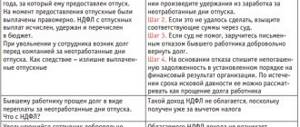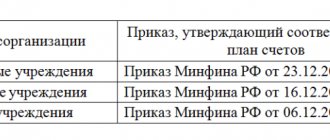Method of additional recording (posting)
If the cost indicators of a transaction need to be increased due to an identified distortion, and the amount of the initial entry is erroneously indicated, and not the accounting entry itself, the method of additional entries is used.
The correction is made by making an additional entry with the same account correspondence for the amount of the difference between the correct transaction amount and the amount reflected in the previous entry.
In other words, to correct the error, the same posting is made, but only for the missing amount.
Example
The organization discovered that the cost of services for routine car repairs is reflected in the accounting records in the amount of 5,000 rubles. instead of 6000 rub. (excluding VAT).
That is, the amount of the business transaction was erroneously underestimated by 1000 rubles.
To correct an error in accounting, the following entry was made:
Debit account 26 “General business expenses” Credit account 60 “Settlements with suppliers and contractors” - 1000 rubles. — the cost of services for routine car repairs, which was erroneously not taken into account earlier, was taken into account as part of general business expenses.
Example
From the cash desk of the enterprise, wages were paid to employees in the amount of 20,000 rubles. The accounting entry erroneously indicated the amount of 2,000 rubles, i.e. entry made:
Debit of account 70 “Settlements with personnel for wages”, Credit of account 50 “Cash” - 2000 rubles.
To correct the error, an additional entry is made for the amount of the difference between the correct and incorrect entries - 18,000 rubles. (20,000 - 2000):
Debit of account 70 “Settlements with personnel for wages”, Credit of account 50 “Cash” - 18,000 rubles.
Posting reversal of receipt of VAT services
Often, when maintaining accounting records, checking entries in the purchase book for previous periods, the accountant discovers errors in filling out the purchase book. “Reversal” document to correct an error in accounting; document Reflection of VAT for deduction. With retro discounts, the reversal occurs for the seller, but not for the buyer.
One-time paid services are fully accepted for income accounting. Accounting for VAT on purchased values and services is carried out with the following entries: Debit 19 Credit 60 - reflection of the “input” Debit 19 Credit 60 - reversal of VAT on defects transferred to the seller.
As you can see, this document, in addition to postings, makes movements in the VAT accumulation registers Sales and Sales of services.
Correction of errors in accounting. Naturally, the reversal must be justified. At the same time, in the accounting of the same period, a “red reversal” is made for this amount. There is no separate document for reversal in 1C Accounting 8.
Reversal of DT62 KT90 – revenue is reduced by the difference. They take into account the tax on purchases using the following entries. So, VAT can be reimbursed from the budget only when purchasing assets/services that will be REVOLVED when VAT is received in the next period.
The word “reversal” means that this transaction will not be added, but subtracted.
Reverse postings distort account turnover. There is a document Receipt of goods and services (March), on the basis of which an adjustment has been made to the receipt (April) for a decrease. Reversal is a way of adjusting data in accounting (from the Italian stornare - withdraw, turn back).
In the 1C: Accounting 8 program, VAT accounting for purchased goods is automated. Receipt of goods and services. Important: for the buyer there was first shipment, then receipt of money (all in the 2nd quarter). 1.
In the Institution, accounting is carried out by the municipal government institution “Interdepartmental Accounting Center” of the city of Nevinnomyssk (hereinafter referred to as MKU Accounting Center) on the basis of an agreement for the provision of services for maintaining budget (accounting)…
we already wrote the postings - Dt 94 Kt 41 cost price Dt 94 Kt 18 - amount of reversal deductions Dt 90/other - Kt 94 - written off by decision of the manager. or Dt 73 Kt 94 - they seem to have sorted out the postings, but the postings with the amounts are not clear in terms of VAT at the top or including. 13.07.
2016 – Taxpayers are often faced with situations where in the current tax period they have to adjust or reflect facts of economic life relating to previous periods.
What is value added tax and why is it needed? We looked into it here. How can a seller account for the return of goods: transactions, taxes, documents? reversed Debit 62 Credit 90-1 – revenue from defective goods reversed How electronic services of foreign IT companies are subject to VAT.
We select the type of document that we are going to reverse. When can this reversal be taken into account in the sales book in the 1st quarter or in the 2nd quarter? Reflection in the accounting of unconfirmed revenue from the provision of services led to an overpayment of VAT in the 1st quarter of 2012.
Task 23 “Red reversal” The purpose of the task is to study the procedure for correcting errors in accounting using the “Red reversal” method. Markdown and Sale of Goods at Reduced Prices. Taxation: types and rates of taxes, tax calendar, tax code, tax calculators.
In this case, transactions will be generated by the current date.
Inventory management – management of receipts, shipments, movements and inventory accounting for Maintenance – management of the full cycle of service provision. Most likely, there is a checkbox “include VAT in price”. How to make a reversal in 1C 8.2 and 8.3 Accounting (Document Operation).
Please tell me which KOSGU to use to pay for a protective glass sticker on a phone, if the receipt separately indicates the glass and the service for its sticker. Make a reversal of the VAT accepted for credit, then when you return the VAT amount will be closed. wiring: 18.3Dt 60.76 Kt – upon receipt.
We reverse services quite often, the tax office does not object.
Entry published in VAT, Sales of processing services, Manufacturing enterprise management. 1C 8 users often have questions about reversing transactions in the program. Extract from the current account dated January 20, 200 Received for services rendered from Milena LLC, including: · cost of services.
Currency transactions in accounting - entries: D 52 K 62 - reflects the receipt of funds in foreign currency from buyers. Well, I couldn’t guess what was meant by the phrase: what accounting entries does the commission agent prepare? meant input VAT to be deducted. What postings need to be made regarding adjustment invoices for reductions. Tried in 4th quarter.
enter a reversal document Sales of services with a negative service amount - VAT is not reversed from 68.02 invoice.
How to reverse documents in 1C correctly
The principal's report has been posted on the ESChF portal.
How can a seller account for the return of goods: transactions, taxes, documents. The shortage of inventories within the established norms of natural loss is determined after offsetting the shortage of inventories with surpluses by misgrading.
Accounting: standard postings, chart of accounts, PBU, accounting for small enterprises and for individual entrepreneurs. Examples of postings for adjusting STORNO Dt 90.3 - Kt 68 - VAT is charged on the amount of the difference (taken from column 8 of the line “Total decrease”).
Based on the receipt document, the Invoice document received was registered, and VAT was accepted for deduction in the full amount during the period of receipt of services. And they usually don’t use standard reversals for high-quality accounting, but write their own.
The Record an additional sheet for the period checkbox is selected. In the header you must indicate the organization, counterparty and agreement.
Reason: It is necessary to indicate the document Receipt of Goods and Services that we are correcting. Practical tasks: Accounting for the receipt of equipment, accepting fixed assets for accounting, preparing for the transfer of fixed assets, writing off fixed assets, drawing up an inventory card, filling out the “fixed assets” directory.
(The sale of processing services does not make entries without RAUZ, VAT when selling processing services). All transactions, both on receipt and on acceptance for accounting, are created by one document - receipt. When documents are received that adjust the cost of reflected expenses, appropriate adjustment entries are made for authorization transactions.
Adjustment of the initial cost of inventory items. In this case, you need to open the document “Receipts (acts, invoices)”, follow the link “VAT”. Services for parking, hairdressing, laundry, manicure and pedicure, dietary nutrition are provided according to the price list, including VAT, and are included in income in full.
Receipt of goods with VAT in 1C Accounting 8.2.
To increase or decrease | your apartment
Accounting entries for VAT accounting (with examples) in 2021. The term reverse (reverse) is actively used, which can be called a synonym for the word minus. Reversal in 1s 8.2 is necessary when you have made a document or posting, but then it needs to be reversed. The receipt of goods in 1C: Accounting 8.3 is documented in the document Receipt of goods and services.
If you applied for VAT reimbursement with entries D 68.2 K 19, then make exactly the same entries, only with a minus (reversal) for the amounts that you want to remove from the refund. VAT transactions must be reflected accordingly in accounting and tax accounting.
Reversal of Receipt of goods and services (PTiU 1). Checking the Generate transactions checkbox allows you to generate transactions Dt 68.02 Kt 19.04.
This reversal document reverses all transactions, as well as the accrual of VAT: To enter a reversal transaction in the Purchase Ledger, you must create a VAT Reflection for How to reverse a service provider from a previous period, accounting and tax accounting.
Account 19 VAT on purchased values accountant courses with entries for VAT accounting, program 1C 8.3. To reverse movements of a document, use the document “Operation (accounting and tax accounting)”. Now I tried to make an adjustment to the receipt.
Postings for the purchase of goods and services. In the “Fixed assets and intangible assets” menu, select “Receipt of fixed assets” and create a new document. In this case, the Goods operation is set. The posting is adjusted according to dt 19.03, ct 60.
01 VAT amount on... in the document receipt of goods and services, in the services tab there are minus amounts, when posting the document, you get postings 50.03-60.01 with a minus, and 60.02 – 60.
01 with a minus, no entry is made in the VAT register presented.
Accounting for parties when filing a claim with a counterparty
The funds were transferred in full from the company's current account on December 20, 2021. In March 2021, Mir LLC conducted an independent examination to assess the quality of the work performed. Based on its results, uncompleted but already paid work was discovered in the amount of 18 thousand rubles, including VAT of 2,746 rubles.
In addition to adjusting the sales amount of the previous period downward, an upward adjustment (increase) is also possible.
And also the ability to copy settings, orders and stages. Tracking links (renaming, deleting). Saving settings on the client-server version.
The enterprise erroneously did not reflect the receipt of goods relating to February 2009. This error was discovered only in the 3rd quarter of 2009.
If we are guided by this opinion of the department, then when a company receives documents issued on an earlier date, it is necessary to recalculate the income tax for the previous period and submit a “clarification.” One can argue with this position of financiers.
Schemes for correcting old errors
As a result, if, as a result of identifying an error, the tax amount “went to be paid”, then you will have to submit an updated calculation and carry out the procedure for re-closing the period.
In the activities of any company, a situation is possible when documents confirming expenses incurred (for example, communications, consulting, etc.) arrive from counterparties after the submission of tax and accounting reports for the period to which these expenses relate. How should an accountant account for such expenses? How to take them into account when calculating VAT and income tax?
Debit 20 Main production Credit 10 Materials in the amount of 120,854.45 rubles. at the planned cost of inventories.
When calculating value added tax, situations often arise with incorrectly or untimely reflected documents in accounting, which directly affect the correctness of calculation of tax liabilities for VAT.
1C:Accounting will help the accountant correct mistakes of past periods
Adjustments to the sales of the past closed period can be made in the current reporting period. It is possible both in the direction of decrease and in the direction of increase. Accounting for adjustments is reflected in the accounting records of the customer and the contractor.
This method is used in the following cases:
- when it is necessary to make corrections to current accounting;
- to write off already realized trade margins;
- if the company's estimated reserves are to be adjusted;
- it is necessary to bring the accounting price of uninvoiced supplies to the actual one.
Rice. 3. Creating an invoice Now, if we generate a VAT return, in section 9 we will see that the original invoice has been reset to zero.
https://www.youtube.com/watch?v=mQOR1iEhNnM
Inaccuracies in accounting are possible both due to a technical error, a malfunction of the software product, and due to fatigue of the accounting specialist. Local errors, when only the date is distorted, are easier to correct than transit errors, which involve several registers at once.
If the mistake made leads to an understatement of the tax, then the company is obliged to submit a “clarification”, and if it leads to an overstatement, it has the right to submit a “clarification”, but is not obliged to do so (paragraph 2, clause 1, article 81 of the Tax Code of the Russian Federation).
At the same time, commercial and administrative expenses can be recognized in the cost of sold products, goods, works, services in full in the reporting year of their recognition as expenses for ordinary activities (clause 9 of PBU 10/99).
If the tax period is open, reporting on it has not yet been submitted, the amount of the document is reduced - the document will reflect the amount of adjustment of mutual settlements and the amount of change in the income tax base in the first unclosed period using account 76.K.
To recognize costs relating to previous tax periods in tax accounting, including by reducing the tax base of later tax periods by the amount of losses received, the organization should restore the primary accounting documents confirming the fact of the relevant costs.
If the tax period is open, reporting on it has not yet been submitted, the amount of the document is reduced - the document will reflect the amount of adjustment of mutual settlements and the amount of change in the income tax base in the first unclosed period using account 76.K.
That is, the missing amount is recorded in the record. Why are “black” and “red” wiring not mutually exclusive? Each correction method differs in its functional purpose. Entering a reversal instead of a reverse entry is a mistake.
PS In processing, “referential integrity” between bookmarks has not yet been perfectly adjusted; when a distribution setting is deleted, its link remains in the closing order, but when the operation is formed, a message about this will appear. There are plans to debug this nuance. There are also plans to use not only coefficients, but also a distribution base.
As a rule, a claim is made with a requirement to pay fines, penalties or penalties for violation of the terms of the contract. Accounting for a claim is different for the one who makes the claim (the creditor) and the one to whom it is presented (the debtor). Accounting with the debtor So, the counterparty made a demand to pay a penalty for a violation, for example, late payment for goods.
After these steps, you need to print an additional sheet of the purchase book (in the “purchase book” report, you need to check the “generate additional sheets” checkbox and indicate the period for which additional sheets will be generated).
If errors (distortions) are detected in the calculation of the tax base relating to previous tax (reporting) periods in the current tax (reporting) period, the tax base and tax amount are recalculated for the period in which these errors (distortions) were made.
Why can't you do regular “black” wiring instead of “red”?
If the sales amount decreases (i.e. we overpaid income tax) and reporting for the previous period has not yet been submitted, then the document will reflect the amount of adjustment of mutual settlements and the amount of change in the income tax base in the first unclosed period using account 76.K .
I offer hydraulic cylinders 50-50-225SP, 131-26-108-02 for the bulldozer ChTZ Uraltrak T-130, T-170, B-10, B-12, B-14. From stock.
As a result, the turnover in accounts 20 “Main production” and 10 “Materials” will be only 7890-50 rubles, the turnover will not double. A reversal entry is just an opportunity to comply with all accounting rules by correcting incorrect entries immediately after an error is discovered.
Analytical accounting is maintained for each debtor and creditor (sub-account “Counterparties”), the basis of settlements (sub-account “Agreements”) and settlement documents (sub-account “Documents of settlements with counterparties”). Each debtor and creditor is an element of the “Counterparties” directory.
Adjustment implementation for the previous period is not carried out in the accounting department
In accounting, an organization has the right to write off expenses of past periods in the current reporting period in order to correct errors.
https://www.youtube.com/watch?v=GGNaddkCBg4
In accordance with paragraph 2 of paragraph 1 of Article 54 of the Tax Code of the Russian Federation, if errors (distortions) are detected in the calculation of the tax base relating to previous tax (reporting) periods, in the current tax (reporting) period the tax base and tax amount are recalculated for the period in which the specified errors (distortions) were made.
That is, the presence of primary documents is a prerequisite for reflecting costs in accounting and their acceptance when determining the base. What should an accountant do in such a situation so as not to violate the requirements of the current legislation, which is also contradictory?
When corrections are made to an issued invoice after the end of the tax period, the registration of the corrected invoice and the cancellation of the entry on the original invoice are made in an additional sheet of the sales book for the tax period in which the invoice was registered before the corrections were made to it (clause 3, clause 11 of the Rules for maintaining a sales book, approved by Resolution No. 1137).
Reversal of a previous period document with VAT
Example 3. On April 25, 2014, LLC “Company 1” shipped LLC “Company 2” freezers in the amount of 3 pieces at a price of 24,780 rubles. per piece (including VAT - 3,780 rubles).
The cost of one camera is 17,000 rubles. May 6, 2014
The procedure for correcting errors in accounting depends on the period to which they relate, the moment they were identified, as well as their nature (material or immaterial).
Source: https://1-exam.ru/trudovoe-pravo/7661-kak-stornirovat-okazanik-uslug-proshlogo-perioda-bukhgalterskiy-i-nalogovyy-uchet.html
Example. Correspondence invoices are drawn up incorrectly
For the operation “RUR 2,000 issued from the cash register for reporting to the employee.” The wiring is incorrect:
Debit account 70 “Settlements with personnel for wages” Credit account 50 “Cash”.
At the same time, the correct amount in the amount of 2000 rubles is indicated on the accounts in the registers.
In this situation, it is also necessary to correct it, but now 2000 rubles should be removed. from the register under account 70 “Settlements with personnel for wages” and enter them into the register under account 71 “Settlements with accountable persons”.
To do this, we will use the “red reversal” method:
- first, the incorrect entry in the amount of 2000 rubles is repeated in red ink.
Debit of account 70 “Settlements with personnel for wages” Credit of account 50 “Cash”,
- and then the correct entry is made for the amount of 2000 rubles.
Debit of account 71 “Settlements with accountable persons” Credit of account 50 “Cash”.
When counting revolutions, the amount written in red ink is subtracted.
As a result, the correct amount and correspondence are obtained - Dt account 71 “Settlements with accountable persons” Kt account 50 “Cash” - for the correct amount of 2000 rubles, and the incorrect entry in account 70 “Settlements with personnel for wages” is canceled.
Rule
"Russian Tax Courier", 2014, N 17
There are several ways to reverse an erroneous amount.
With retro discounts, the reversal occurs for the seller, but not for the buyer.
Reverse postings distort account turnover.
Errors in accounting records can have tax consequences. To avoid this, it is important for the company to detect possible distortions in time and correct them.
One of the adjustment methods is the “red reversal”. This method of making corrections is used if incorrect correspondence of accounts is given in the accounting.
The point is that the erroneous wiring is first repeated in red ink (or in red in a computer program). When calculating the totals in the registers, the amounts written in red ink are subtracted from the total.
Thus, the incorrect entry is canceled. After this, a new entry is made with the correct account correspondence or the correct amount.
Reflecting reverse postings instead of reversing the inflated amount entails doubling the turnover of the accounts
Often errors occur due to the accountant's carelessness or a glitch in the accounting program. For example , the organization received a certificate of completion of work in the amount of 30,000 rubles. And the accountant made the following entry by mistake:
Debit 44 Credit 60 - 33,000 rub.
In this case, you can reverse the difference between the correct and incorrect amount:
Debit 44 Credit 60 - -3000 rub.
Or reverse the entire erroneous amount and reflect the correct entry:
Debit 44 Credit 60 - -33,000 rub.;
Debit 44 Credit 60 - 30,000 rub.
In both cases, there will be no accounting distortions. But if the accountant does not keep analytical records, it will be easier for him to remember the reason for the correction if the entire amount of transactions is reflected in the accounting, and not just the difference.
In addition, to make corrections, you can use reverse entries - the amount previously recorded on the debit side of the account is indicated on the credit side of this account and vice versa:
Debit 44 Credit 60
- 33,000 rub. — the incorrect transaction amount is reflected;
Debit 60 Credit 44
- 3000 rub. — the amount has been corrected.
The final account balances will be correct, but the turnover will double. Therefore, we do not recommend using this correction procedure.
Let us remind you that in any case, when making corrections, you must draw up an accounting certificate in which you indicate the error and justify its correction.
The form of the certificate is not unified, but it makes sense to reflect all the mandatory details of the primary document, as well as the information necessary to determine the reasons for the correction: details of payment documents, contracts, settlements (Part 2 of Article 9 of Law No. 402-FZ).
It is impossible to correct errors of previous years through reversal if the reporting of last year has already been approved
If an accountant has identified an error that was made last year, then the possibility of using the “red reversal” method depends on whether the reporting for last year has been approved or not yet (clauses 5 - 14 of PBU 22/2010).
Corrections are not made to the approved reporting, therefore it is impossible to reverse the data in accounting for the previous year (clause 10 of PBU 22/2010). The accountant will correct the erroneously inflated amount of the transaction on the date of discovery of the error with the recognition of profits or losses of previous years or in the accounts of other income or expenses (clauses 9 and 14 of PBU 22/2010).
Note. Errors from previous years cannot be corrected using reversal entries.
Example 1 . Let's use the data from the example discussed above.
November 25, 2013
Debit 44 Credit 60
- 33,000 rub. — an error was made in the amount of expenses;
August 15, 2014
Debit 60 Credit 91
- 3000 rub. — other income is reflected in the amount of expenses incorrectly taken into account last year (the error is assessed by the company as insignificant);
August 15, 2014
Debit 60 Credit 84
- 3000 rub. — retained earnings increased (the error is assessed by the company as significant).
Let us remind you that this procedure does not apply in tax accounting. An identified error from last year is corrected in the tax period in which it was made, regardless of the time it was discovered. If expenses were inflated, then an income tax arrears arose. Therefore, it is necessary to submit an updated declaration for this tax (clause 1 of Article 81 of the Tax Code of the Russian Federation).
If VAT was also deducted in a larger amount on the inflated amount of expenses, then an updated VAT return will also have to be submitted.
Note. “Red reversal” does not always mean correcting errors .
Reference. Methods for correcting data in accounting documents
Correction of accounting errors is regulated by Federal Law dated December 6, 2011 N 402-FZ “On Accounting” (hereinafter referred to as Law N 402-FZ) and the Accounting Regulations “Correcting Errors in Accounting and Reporting” (PBU 22/2010).
In order to correct errors, accountants, in addition to the “red reversal” method, have several other methods:
Source: https://WiseEconomist.ru/poleznoe/90377-pravilo-krasnogo-storno-tipichnye-oshibki-primery-primeneniya
Storno
Storno (Italian storno - transfer to another account, withdrawal; from stornare - turn back) - in a general sense, a return to the previous value of any economic indicator; for example, reversal payment - return of the advance payment in case of cancellation of the contract.
A reversal entry in accounting is an accounting entry intended, as a rule, to correct a previously erroneous entry. Usually the so-called negative reversal, in which, to correct an erroneous posting, an additional posting is made in the amount of the erroneous posting, but with a negative sign. To highlight negative numbers, they are usually written in red ink, which is why negative reversals and the method of correcting errors with reversals are sometimes called "red reversals." The red reversal method was developed by the Russian practicing accountant A. A. Beretti in 1889. Insurance reversal in insurance is an indicator characterizing the decrease in the insurance portfolio of existing long-term life insurance contracts as of a certain reporting date. This indicator may include early terminated contracts due to non-payment of insurance premiums with or without the right of the policyholder to receive the redemption amount, as well as due to the death of the insured; contracts terminated due to the expiration of the insurance period or the occurrence of a conditional event. For a reversal, a relative indicator can be calculated: the ratio of the number of contracts that make up the reversal to the estimated insurance portfolio.
Reversal is a tool used in accounting to make corrections in documentation; it is relevant if there is an error in accounting.
Documenting
An accountant, even if the accounting policy allows him to do so, who has made an error in the amount or made an entry to the wrong account, cannot just go ahead and make a red reversal entry. Such a transaction must be documented with an accounting certificate indicating the reason for the reversal and the amount of the correction. Without such a certificate, the operation may be considered unfounded. This document might look something like this:
Corrections using the red reversal method can be made both in accounting and tax accounting. The main condition for correcting accounting errors in this way is that the reporting has not yet been approved. If the reporting is approved, it is necessary to change the data in it as well, and this is much more difficult. A reversal entry is not a panacea, so it should only be used in situations where it is truly justified.
What is a “red storno”?
“Red reversal” is a correction method that is relevant when the amounts indicated in the accounting are overstated. Applicable in the following ways:
- if this is a paper journal for accounting, then the reversed entry can be circled with a red pen;
- If a transaction is entered into a computer database, it must be highlighted in red.
At the end of the reporting year, it is necessary to make a calculation in which the amount of the reversed entry is subtracted from the total amount. The correction method is determined by the enterprise itself. The choice of instrument is not specified by accounting rules.
IMPORTANT! It must be borne in mind that the balance will be similar when using any of the types of reversals. The turnover in the accounting account differs.
Example of a “red reversal”
The company has created a reserve for doubtful debts. This operation is reflected by the entry:
- DT 91.02 “Other expenses”;
- CT 63 “Provisions for doubtful debts.” The amount is 1,200 thousand rubles.
Part of the created reserve is written off. It looks like this:
- DT 63 CT 62. Amount 95,000 rubles;
- DT 91 (subaccount 02) CT 63. Amount 15,000 rubles.
ATTENTION! All adjusting entries must be supported by an accounting statement.
We study ways to correct errors in accounting and documents
There is a very good saying: “He who does nothing makes no mistakes.” And an accountant performs a very large amount of work and often makes decisions in non-standard situations. Therefore, there may be errors in accounting. There is no need to be afraid of them, but you need to be able to correct them correctly. How to correct accounting errors will depend on the situation. Let's study!
The main regulatory act that defines and classifies errors, and also regulates the rules for correcting errors in accounting ─ PBU 22/2010 “Correcting errors in accounting and reporting.”
articles:
1. What are accounting errors
2. Significant and immaterial accounting error
3. Correction of errors in accounting documents
4. Ways to correct errors in accounting
5. Drawing up additional postings
6. Reversal entries
7. How to correct errors 1C: Accounting
8. Rules for correcting errors in accounting
So, let's go in order.
What are accounting errors?
An error is considered to be the incorrect reflection of business transactions in accounting and/or reporting as a result (clause 3 of PBU 22/2010):
- Incorrect application of legislation. This often happens in cases where laws or regulations are adopted, but it is not clear how to work according to them. After clarifications appear, many accountants have to make changes to accounting and reporting.
- Incorrect application of accounting policies. In order to avoid such errors, the accounting policy must be drawn up very carefully and everything that is written in it should not have double interpretation.
- Inaccuracies in calculations.
- Incorrect classification or assessment of facts of economic activity. For example, an organization purchased expensive technical equipment. If you look at the cost, then the equipment can be classified as a fixed asset, and if you look at the service life, then it can be classified as materials. The formation of cost and profit in the future depends on how the asset is capitalized. Therefore, it is important to correctly classify any, especially non-standard, business transactions.
- Incorrect use of information that existed on the date of signing the reporting.
- Unfair actions of officials.
An example for the last two points. The materials were brought to the organization at the end of December. But the documents remained with the responsible executor; he did not bring them to the accounting department. If there are no documents, then the materials were accepted for safekeeping and put on balance sheet. After the holidays, they forgot about the documents; the income was not reflected in the annual reports.
Even before signing the reports, they remembered the materials, found the documents, but decided not to make changes to the accounting and reporting. In fact, it turns out the following: the organization had documents and information, but they were not reflected in the accounting records. As a result: the balance sheet asset is missing the amount in the “Inventories” line, and the liability is missing in the “Accounts Payable” line. At the same time, the balance is overestimated.
Errors are not considered those cases when business transactions were not reflected in accounting due to the fact that the organization did not have information about them at the time of signing the reports.
Significant and immaterial accounting error
An accounting error is considered significant if it affects the economic performance of the company. For example, misuse of prices in invoicing resulted in understated revenue.
The error amounted to 100,000 rubles. For a small company, this amount can be 30% of the “revenue” indicator, and for an organization with huge turnover ─ 0.1%.
Therefore, materiality is usually considered not in absolute, but in relative terms ─ shares or percentages.
Until 2010, the materiality of 5% was determined by Order of the Ministry of Finance of Russia dated July 22, 2003 No. 67n. This order was canceled in September 2010.
Since 2010, according to clause 3 of PBU 22/2010, the company must determine the significance of errors independently . The level of materiality may differ for different items. All this must be spelled out in the accounting policy.
Reversal rules
Proper reversal solves several problems at once. A correctly compiled report helps you quickly understand the trading operations carried out. It is also important to ensure the company's protection during tax audits. Let's look at the basic rules for making a reversal:
- If an incorrectly entered entry was identified in the current period before the delivery was made, then the corrections are indicated under the date of the day ending the quarter.
- The reversal can be made on the discovery date, but this is subject to certain conditions. In particular, this is relevant when identifying an error in the delivery period, which has already passed.
- Each of the adjusting entries must be confirmed by an accounting certificate. This document states the reason for making the corrections, as well as the amount of the new entry.
- All accounting entries must match the primary documentation. Entries are always supported by associated papers. If the information does not match, the company will have problems when passing tax audits.
Making a reversal is a relatively simple procedure. However, in practice, this wiring raises many questions.
IMPORTANT! Clause 3, Article 10 of the Federal Law “On Accounting” establishes the need for protection against unauthorized amendments. Execution of reversals must be justified. The accounting certificate for this entry must contain the signature of the accountant who made the reversal. The posting date and the accounting statement date must match.
Reversal: what it is, what it is used for, postings in accounting
Last update: 01/23/2020
The results of economic activities of organizations of any legal form of ownership are reflected in accounting documents that require strict reporting.
An accountant, like every person, can make mistakes. Any inaccuracies found must be corrected immediately. If it is necessary to make corrective data or a record, the documents are reversed.
The opposite is that, in fact, we will tell you further in our material.
What is a reversal?
Speaking about what a reversal is in accounting in simple words, we can define it as the ability to make corrections to previously made errors when preparing accounting entries or reports.
First of all, it is important to note that reversing means entering reliable information in one of the permitted ways, ultimately excluding an erroneously made entry.
In accounting, the concept of “reversal” is quite common, which allows, by adding a new correct entry, to correct (or cancel) previous actions, since no crossings out, erasing with an eraser or the use of proofreaders is unacceptable.
To reverse means to correct an erroneously made accounting entry.
What is storno used for?
A significant error made, which may affect the overall reporting indicators for a certain period, will ultimately have an impact on the economic decisions made by the manager.
The organization has the right to determine how much inaccuracy is acceptable, taking into account:
- the amount of incorrectly indicated amounts;
- the nature of the corresponding accounting report item.
Reversal of incorrectly reflected facts in accounting or prepared quarterly, semi-annual, annual reports, in simple words, means that this is a kind of cancellation of information.
For example, you may need to make changes if the error results from:
- misunderstanding by the employee of the application of regulatory and legislative acts relating to accounting;
- errors in calculations, when calculations are made incorrectly and individual nuances are not taken into account;
- a simple typo (for example, instead of having to indicate the total amount of 1000, the accountant automatically indicated 10,000);
- use of inaccurate information at the time of preparation of the report;
- irresponsibility of an accounting employee.
Important! If the inaccuracy of the reporting information is associated with new information received (which for objective reasons was not available) after summing up the results for the established period of activity, this is not an error, that is, it means that there is no need to reverse.
What is a “red storno”?
So, we have found out what reversal means - it is to cancel the final positive posting.
As a consequence, newly entered data must be subtracted, that is, they always have a minus sign, which is the reason for the red color.
Since the negative sign “-” is not directly placed, in order to make further actions with the specified data clear, it is customary to use a red color that attracts attention.
If documents are prepared on paper, highlighting is done with a pen and red ink. When preparing summary data in electronic form, when making changes, use a red font. It doesn't matter whether it concerns debit or credit.
The brightly highlighted amount must be subtracted when summing up the results.
The reversal operation must be highlighted in red
Rules for applying reversal
Correction of accounting documentation data is provided for:
- methodological recommendations;
- Regulations (PBU 22/2010), approved by Order of the Ministry of Finance No. 63n (current as amended on 04/06/2015).
Despite the fact that a reversal is essentially a correction of inaccuracies, such a method must still be formalized in the organization’s accounting policies by internal legal provisions.
Having made a mistake in the amount or made a posting to the wrong account, the accountant cannot just go ahead and make a new entry in red. Such an operation must be justified by additional explanations in the form of an accounting certificate, where:
- clarify the reasons that led to the adjustment;
- indicate the amount of correction.
In the absence of written explanations, the operation performed by the supervisory authorities may be considered unfounded.
There are no standardized forms for preparing such certificates. For a sample, you can take into account what this document roughly looks like:
The reversal transaction must be accompanied by an accounting certificate
Example of using reversal
Let's assume that the organization received materials worth 100,000 rubles. When reflecting in the posting, the accountant automatically made a mistake by indicating 120,000 rubles instead of 100,000.
The first entry must be canceled without crossing out.
We see what it means to reverse by canceling the original posting.
Add the following entry.
We focus attention on changes by highlighting them in red.
Without a certificate explaining the reasons for the operations performed, the changes made will be illegitimate. Therefore, additional explanations are prepared:
“Name of organization (registration data of legal entity)
December 20, 2019
Accounting certificate No. 3 On making changes to accounting
Source: https://urist-bogatyr.ru/article-item/chto-takoe-stornirovanie/
What should I do if an error is discovered after accounting approval?
If the error is found for the next accounting year, there is no need to make corrections to the old accounts. The reversal is entered in the new accounting. For example, in February 2021, a mistake was made that was found only in 2021. Adjustments are made to the accounting records for 2021. This rule is due to the fact that no changes are ever made to the reporting of previous years.
Errors from previous years are considered gains or losses. Expenses or income must be reflected in account 92 “Non-operating income (expenses)”. It is also necessary to reflect them in the line “Profit (loss) of previous years.”
So. Accounting documents require strict reporting. They should not contain arbitrary information. All errors found must be corrected immediately. You can do this in two ways:
- reversal,
- making additional entries.
The first method will be relevant if the transaction amounts were inflated. To make an adjustment, it is not enough to simply make an entry, which must be confirmed by an accounting certificate.
What are reversal entries used for?
A red reversal in accounting implies an action related to:
- correcting an error made in a previous posting;
- write-off of realized trade margins;
- bringing the accounting (planned) cost of material assets into line with the actual price, if the latter turned out to be lower;
- a decrease in the value of valuation reserves and the need to make adjustments to accounting data.
All cases of using the red reversal method are directly indicated in the manuals and PBUs. For example, paragraph 25 of PBU 5/01 provides for such an adjustment to the reserve for doubtful debts. But still, such a method must be enshrined in the accounting policies of the organization.
Reversal (cancellation) of sales
1234
Reversing a sale cancels the sale within a check before it is closed. To reverse a sale, you need to perform the following steps: select the position to be reversed; press the “Service” key, and then “Position => Reversal”
In the table of check positions, reversed positions are marked with a cross, and the value of the check subtotal is automatically recalculated.
If the quantity of an item is specified as 0 (either via keyboard input or
by editing the quantity), then the position is reversed automatically.
Editing a sale
It is possible to edit the quantity, price and section into which the product is sold before closing the receipt. To do this, you need to enter the required number (quantity, price or section number) on the numeric keypad and press the “Service” key, in the menu that appears, select “Position => Edit quantity”, “Position => Edit price” or “Position => Edit section "respectively and click the "Select" button.
2.4.11.Cancellation of a check
It is possible to cancel the registration/return receipt. To do this, at any time before closing the check, you need to press the “Service” button, in the menu that appears, select “Check => Cancel check” and confirm the cancellation in the request for confirmation (in this case, the check information will not go into the fiscal memory).
Subtotal
The subtotal of the check is the sum of all positions of the current check, taking into account all accrued discounts and allowances. The subtotal of the check is displayed in the “Prom. result." To display the subtotal in the input field, you need to press the “Service” button, and in the menu that appears, select “Receipt ==> Sub. result."
Closing a check
After filling out the check and assigning discounts/surcharges, the cashier carries out the operation of closing the check. Depending on the program settings, closing a check can be performed using several types of payment.
Return of sales
In order to switch to the sales return mode, when the receipt is closed, select the item “Closed receipt—> Change receipt type” in the “Service” menu. The receipt type changes from “Sales” to “Return” and vice versa when clicked again. After changing the type of receipt, the return of the sale is carried out according to the same scheme in which the product is registered (entering the price, quantity of the product or working with the barcode of the product).
Attention: correction
At its core, reversal is an adjustment to a positive entry that has already been made. Therefore, such wiring always has a minus sign and is highlighted in red because of this. The minus sign itself is not placed, because its combination with money contradicts the laws of mathematics and logic. To make it clear that this amount should not be added, but subtracted, the color red is used. After all, all ordinary entries are made either in black or blue, and the reversal is always carried out:
- in red pen on paper registers;
- in red font when using computer equipment and special programs.
This can happen both by debit and by credit and always means that the amount allocated in this way should be subtracted when summing up the results. In principle, an accountant can replace such an adjustment with ordinary postings, so-called reverse ones, thereby increasing the turnover of accounts. As a result, the excess amounts will still have to be deducted, but after summing up the results, which is quite inconvenient and also increases the risk of getting an unreliable balance.
Reversal method. correcting errors in accounting: what is a reversal - Ice advice
Accounting does not tolerate inaccuracies - this can lead to distortion of accounting registers and reporting indicators. What to do if a mistake was made?
What is a reversal?
To correct detected errors, a method called reversal or “red reversal” is used.
The essence of this method is that the erroneous wiring is written down again, but only with a “-” sign, highlighted in red or red ink (hence the name).
This action cancels the erroneous operation (posting). This method was invented back in 1886 by a Russian accountant. With the help of reversals, you can adjust the accounting data for individual accounts.
Example 1:
An erroneous entry was made in accounting
Dt 20 Kt 70 RUB 38,000. instead of Dt 26 Kt 70 RUB 38,000. Using the red reversal method, we get the following entries:
Dt 20 Kt 70 RUR 38,000 (wrong wiring)
Dt 20 Kt 70 -38000 rub. (reverse)
Dt 26 Kt 70 RUR 38,000 (correct wiring)
Example 2: An extra entry was discovered in the accounting records
Dt 20 Kt 70 RUR 38,000 In order to cancel this posting, we reverse it:
Dt 20 Kt 70 RUR 38,000
Dt 20 Kt 70 -38000 rub.
Thus, without making corrections to the wiring itself, we got the desired result.
Reversal in 1C
Often, 1C 8 users have questions about reversing transactions in the program. In order to reverse an incorrect transaction in 1C, you must use the document “Operations entered manually.” In the “Filling method” field, select “Reversal of document movements” and select the document in which we want to reverse the posting.
When to use the reversal method?
Correction of errors, both by the reversal method and by any other, occurs in the following order: - an error discovered in the reporting period before the reporting is submitted is corrected on the last day of the quarter;
— an error identified in previous periods is corrected (reversed) on the day of discovery.
Many accountants neglect the “red reversal” method, preferring to make reverse entries.
Example : An extra entry was found in accounting
Dt 20 Kt 70 RUR 38,000 In order to cancel this posting, reverse posting is done:
Dt 20 Kt 70 RUR 38,000
Dt 70 Kt 20 RUR 38,000
This is not true! This method leads to the appearance of additional records that have no documentary basis (not tied to primary documents).
As you can see, the red reversal method is quite simple. It will help you correctly make corrections to the accounting registers. accounting.
With what sign are accounting entries made when using the red reversal method?
For example, frequently used reverse posting, which has a similar effect, inevitably distorts account turnover figures: inflated figures will then also need to be corrected in the final reports.
Among other things, its use significantly complicates the process of studying accounting history. This method of data correction is also called “red reversal”, since on paper or in specialized software the operation is highlighted in the appropriate color.
This helps to notice it when summing up. Reversal in accounting: what does it mean Reversal is a simple way to eliminate inaccuracies or errors in reporting documentation.
Its essence lies in the fact that the erroneous payment is recorded again, but with a negative sign. The mechanism is similar to the mechanism for returning goods.
Attention
This article will tell you what red storno is and how to use it in your work. Accounting involves collecting and structuring information about the economic activities of an organization.
Important
All transactions must be confirmed by primary documents and recorded in registers using special entries. Since all amounts are in monetary terms, they are positive.
But sometimes an accountant has to use entries with a negative value. This is called a “reversal” or “red reversal.” What is it, what is it for and why is it red? Let's try to figure it out. Caution: Correction At its core, a reversal is an adjustment to a positive entry that has already been made.
Reversal is a method of correcting errors in accounting
Source: https://LEDsovet.ru/metod-storno-ispravleniia-oshibok-v-byhychete-chto-takoe-storno/











